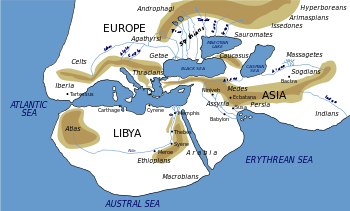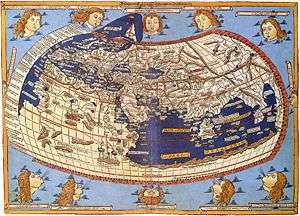Ecumene
The ecumene (US) or oecumene (UK; Greek: οἰκουμένη, oikouménē, lit. "inhabited") was an ancient Greek term for the known world, the inhabited world, or the habitable world. Under the Roman Empire, it came to refer to civilization and the secular and religious imperial administration. In present usage, it is used as the noun form of "ecumenical" and describes the Christian Church as a unified whole or the unified modern world civilization. It is also used in cartography to describe a type of world map (mappa mundi) used in late Antiquity and the Middle Ages.
Etymology

The Greek term is the feminine present middle participle of the verb οἰκέω (oikéō, "to inhabit") and is a clipped form of οἰκουμένη γῆ (oikouménē gē, "inhabited world").[1]
Greece
Eratosthenes of Cyrene (276–196 BC) deduced the circumference of the Earth with remarkable accuracy (within 10% of the correct value). The Greek cartographer Crates created a globe about 150 BC.[2] Claudius Ptolemy (83–161) calculated the Earth's surface in his Geography and described the inhabited portion as spanning 180 degrees of longitude (from the Fortunate Isles in the west to Serae and Serica (China) in the east) and about 80 degrees of latitude[3] (from Thule in the north to anti-Meroë below the equator). Ptolemy was well aware that the Romans knew only about a quarter of the globe and his erroneous belief that the Indian Ocean was landlocked led to expectation of an terra incognita ("unknown land"). In fact, symmetry led him to expect that there should be three other continents to balance the ecumene: Perioeci (lit. "beside the ecumene"), Antoeci ("opposite the ecumene") and the Antipodes (“opposite the feet”).
Rome
The cameo Gemma Augustea includes a Roman artistic personification of Oikoumene as she crowns an emperor, probably Augustus, perhaps for bringing peace to the (Roman) world.

The word was adopted within Christianity after Constantine the Great's assembly of a synod of bishops from all over the world at the First Council of Nicaea in 325.
By that time, the Greek term had come to refer more specifically to the civilized world and then simply the Roman Empire. This usage continued after the Diocletian Reforms and the Byzantine emperors used it to refer to their imperial administration. Constantinople was the "Ecumenical City" and, after 586, the Patriarch of Constantinople was known as the "Ecumenical Patriarch of Constantinople". Pope Gregory I objected to the adoption of this style by John IV of Constantinople, as it implied a universal jurisdiction he believed to be held by the bishop of Rome.[4] His Fifth Epistle berates John for having "attempted to seize upon a new name, whereby the hearts of all your brethren might have come to take offence",[5] despite the title having been granted at the emperor Maurice's behest.
The name continues to be borne by the Greek Orthodox patriarchs, although with the more restricted sense that they are the bishops of the former imperial capital.[6]
Modernity
Religion
In the 20th century, the term has been employed to refer to unified Christian Church which is the ultimate goal of Ecumenism, a movement to promote cooperation among the various Christian denominations. The movement is not accepted by many Christian groups. The work of ecumenism takes place in the form of negotiations conducted between committees of various denominations and also through the deliberations of inter-denominational organizations such as the World Council of Churches. Relevant issues include Baptism, the Eucharist and Ministry.
Culture

In the context of cultural history, the term was first used in an academic sense by Lewis Mumford in his work, Technics and Civilization (1934)[7] and later popularized by William H. McNeill's "Rise of the West". McNeill suggested that a single global ecumene was created through the dominance of European political institutions, science, technology, and economic forms from the late 18th century onwards. One could argue that prior to the great voyages of discovery, initiated by Christopher Columbus, Vasco da Gama, and Ferdinand Magellan, there were originally two separate ecumenes—one covering the Old World and one the New. It was the Spanish conquistadores that fused this second ecumene to the first to create a single integrated "world system".
It must be said that the "ecumene" can differ depending on the viewpoint from which it is perceived: for example, Ancient Babylonians would be familiar with a different area of the world than the Ancient Greeks (though they may overlap). See image to the right.
Cartography
The term is used in cartography and the historical cartography to describe a type of symbolic, schematic world map made in late Antiquity and the Middle Ages.
Fiction
- The author J. R. R. Tolkien described his Middle-earth setting for his fiction as equivalent to the Greek ecumene, the abode of Man.
- In the Demon Princes series of science fiction novels by Jack Vance, the Oikumene is the term used for the human-inhabited worlds of the galaxy.
- In the science fiction novel Time's Eye co-authored by Arthur C. Clarke and Stephen Baxter Oikoumene is a grassroots religious unification movement bridging the divide between the Catholic Church and Islam.
- In Hainish Cycle of fiction novels and stories by Ursula K. Le Guin, the Ekumen is a loose confederation of inhabited worlds, linked by instantaneous communication, but separated by slower-than-light travel.
- In the science fiction trilogy The Golden Oecumene, by John C. Wright, a polity called the Golden Oecumene spans all of the Solar System.
- In the Halo universe, more particularly in Halo: Combat Evolved Anniversary and the Forerunner Saga novels, the Forerunner Ecumene spanned the galaxy more than 100,000 years ago.[8] Forerunner society was divided into five main social classes, called "rates" (in ascending order of social standing/power): "Engineers", "Warrior-Servants", "Lifeworkers", "Miners", and "Builders".[9]
References
- ↑ Oxford English Dictionary. "œcumene, n."
- ↑ Klein, Samuel John (2005), "Oecumene", Cartography Word of the Day, Designorati, retrieved 2008-01-03
- ↑ Although Ptolemy did not measure latitude with degrees but with hours of midsummer daylight, from 12 at the equator to 24 in the arctic.
- ↑ Schaff, Philip (1882), "Gregory and the Universal Episcopate", History of the Christian Church, IV: Mediaeval Christianity: A.D. 590–1073, Peabody, Massachusetts: Hendrickson Publishers; 3rd edition (July 1, 1996), ISBN 978-1-56563-196-0, retrieved 2008-01-03
- ↑ St Gregory the Great. Epistle V, §xviii.
- ↑ "The Universal Patriarch", The Witness (PDF), XXV, No. 13, August 3/16, 1981, Boston, Massachusetts: Holy Transfiguration Monastery, retrieved 2008-01-03
- ↑ Mumford, Lewis (1934), Technics and Civilization, New York: Harcourt, retrieved 2008-01-03
- ↑ Halopedia – Ecumene
- ↑ Halopedia – Rate
External links
- The Apotheosis of Homer showing personification of Oecumene
- Pope Gregory and the Universal Episcopate
